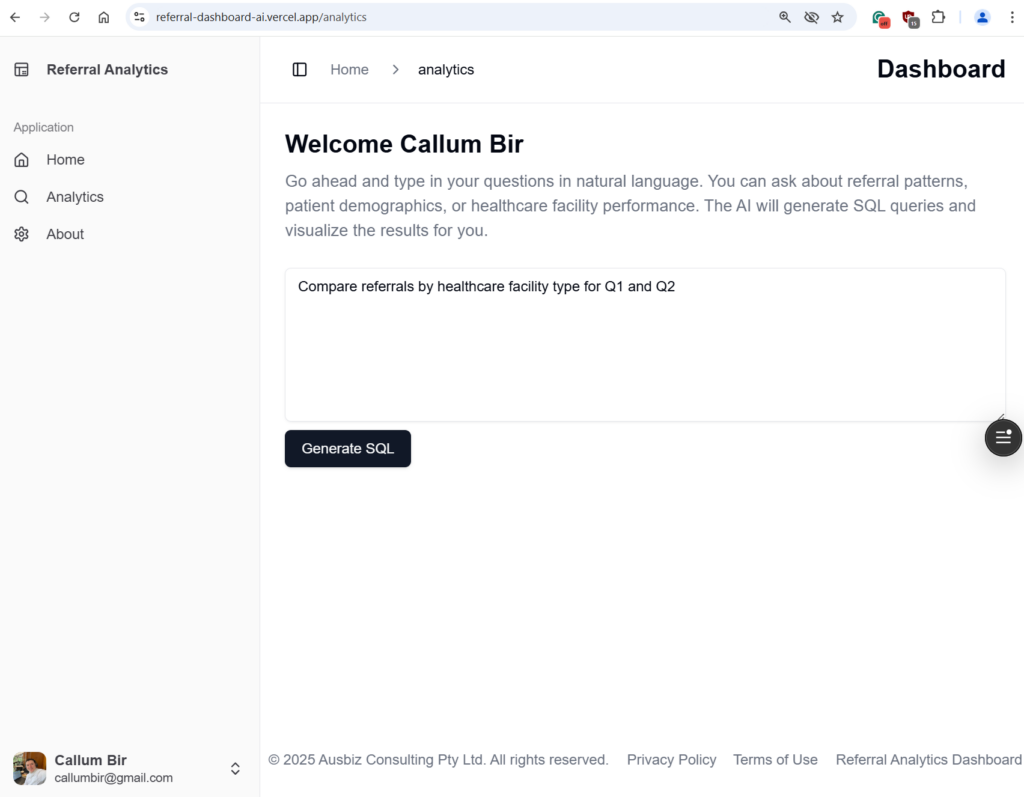Analytics has long been the cornerstone of informed decision-making. Traditionally, businesses have relied on a multi-step, human-driven process where insights are painstakingly gathered, curated, and visualized using tools like Power BI, Qlik, Tableau, and even Amazon QuickSight. However, the rise of generative AI is poised to disrupt this process—and with it, the very way we make critical business decisions.
In today’s conventional approach, business analysts or insights specialists work closely with technical reporting experts. They craft detailed mockups, specifying chart types, axes labels, inclusion and exclusion criteria, and even pseudocode that describes the data tables and query parameters. This collaboration is built on an assumption: that the raw data is already stored in a data lake, waiting to be surfaced.
The Traditional Analytics Process: A Recap
Typically, the journey starts with a business analyst or insights specialist. Their role is to understand the business requirement, which often involves multiple rounds of brainstorming and documentation. They might produce a detailed blueprint that includes:
- Mockups of Charts and Graphs: A rough sketch of what the final visualization might look like, including the x/y-axis, labels, and color coding.
- Data Specifications: Detailed descriptions of the tables, attributes, and query parameters—covering inclusion/exclusion criteria and any necessary joins or look-ups.
- Tool-Specific Requirements: Indications on whether the output should be integrated into Power BI, Tableau, or Qlik, and how it should relate to other reports on the dashboard.
Once these requirements are finalized, the business analyst collaborates with a technical analytics specialist. This person, proficient in a specific tool, transforms the requirements into a functional report. Multiple rounds of review and validation follow, involving discussions with data teams who have deep insights into the data dictionary, evolving schema, and intricate business rules that aren’t immediately evident from the data lake alone.
Despite this structured process, the reality is often far from ideal. Building and refining these reports can take months—even up to nine months in some cases—especially when resource constraints and shifting business priorities come into play. Moreover, even after a report is “finalized,” business operations teams frequently find themselves re-extracting data into spreadsheets for ad hoc analyses or tweaking visualizations to meet evolving needs.
The Gen AI Disruption: Incremental Improvements vs. a Paradigm Shift
Generative AI offers a tantalizing promise: to dramatically shorten and streamline this entire process. But the critical question for leaders today is whether to incrementally enhance the existing framework or to completely rethink how analytics is performed.
Option 1: Incremental Improvement
The first approach is evolutionary. In this scenario, we continue with our existing analytics framework—but with a twist. We integrate generative AI tools at various points in the process to reduce friction and accelerate timelines. For instance:
- Mockup and Requirement Generation: Tools like ChatGPT or Claude can help generate detailed mockups and user story tickets from simple natural language prompts. Instead of spending days documenting the requirement, teams can produce a draft in minutes.
- Guided Report Development: Modern BI tools such as Power BI, Qlik, and Tableau are increasingly integrating AI features. These platforms can now suggest the best chart types, automate parts of the query creation process, and even provide recommendations based on the data trends.
- Enhanced Collaboration: AI can serve as a virtual assistant, facilitating discussions between business analysts and technical teams. For example, it can summarize long email threads or meeting notes to highlight key decisions and requirements.
Incumbent tool makers are not standing still; they are embracing generative AI to improve their offerings gradually. This means that organizations may not need to overhaul their entire analytics ecosystem immediately—they can start by adopting AI-enhanced features within their current tools.
Option 2: A Paradigm Shift in Analytics
The second approach is radical: re-imagine the analytics process from the ground up. Here, we leverage generative AI not merely as an add-on, but as the core engine that drives end-to-end analytics. This involves an upfront investment in fine-tuning models—using techniques like Retrieval-Augmented Generation (RAG) and other innovative methods—to build an AI system that understands:
- Data Dictionaries and Business Rules: The AI is trained on the nuances of the organization’s data, including the evolving data schema, coded data (like ATSI or public holiday data), and intricate business logic.
- Contextual Business Questions: With this deep understanding, the AI can interpret business questions accurately—even correcting errors in the query—and generate precise SQL or equivalent queries on the fly.
- Real-Time Visualization: Beyond querying, the system can analyze the output data, decide on the most effective visualization (time series, pie chart, bar graph, etc.), and dynamically generate charts complete with appropriate labels and annotations.
I recently created a public demonstration prototype, which you can explore here. In this prototype, I used synthetic data simulating healthcare referrals from primary care physicians. The system is designed to understand context-specific details—like Australian postcodes, regions, and coded data—and can answer queries such as:
- “Compare referrals by major regions within NSW state for the last quarter.”
- “Analyze referrals by different ATSI status in the past 3 months.”

In response, the AI generates SQL code safely (taking precautions against code injection and other vulnerabilities) and determines the most appropriate chart type to present the insights in real time. This approach is disruptive because it redefines the entire process: from asking a business question to receiving an instantly generated, fully contextualized visualization.
Weighing the Options: What Should Leaders Consider?
For executive leaders, the decision is not simply about choosing one path over the other—it’s about understanding that these options are not mutually exclusive. Rather, they represent a continuum of innovation:
- Short-Term Enhancements:
- Risk Mitigation: Incrementally integrating AI into existing processes carries lower risks. Organizations can improve efficiency without overhauling systems that are already deeply integrated into their workflows.
- Cost-Effective: By leveraging current tools enhanced with AI capabilities, companies can achieve significant improvements in speed and accuracy without a massive upfront investment.
- Familiarity and Comfort: Employees are already accustomed to platforms like Power BI, Tableau, and Qlik. Incremental changes mean less disruption and a smoother transition.
- Long-Term Transformation:
- Unparalleled Speed and Agility: A completely AI-driven analytics system could potentially reduce the report-building cycle from months to minutes, enabling real-time decision-making.
- Holistic Insights: Such a system wouldn’t just generate reports—it would synthesize insights, automatically correlate disparate data sources, and provide contextually relevant visualizations.
- Empowering End Users: With AI at the helm, even non-technical users could interact directly with data. They could simply ask a question and receive a comprehensive answer without waiting for a technical team to intervene.
The Reality of Incumbent Tool Makers
It’s important to note that the traditional analytics vendors are not oblivious to these changes. Power BI, Tableau, Qlik, and even Amazon QuickSight are investing heavily in generative AI and machine learning features. Their evolution means that, in the short to medium term, the incremental improvement approach is not only viable but also backed by robust support and a familiar user interface.
However, the broader disruptive potential of generative AI remains. The question for leaders is: Should we wait for these tools to gradually evolve, or do we take a bold step to reimagine analytics entirely?
A Food for Thought for Executives
This is the pivotal decision that leaders in every sector must grapple with. On one hand, there is the comfort of evolution—improving what works and reducing risk. On the other hand, there is the potential for a paradigm shift—an entirely new way of engaging with data that promises unparalleled speed, agility, and insight.
- Incremental Integration: A strategy that builds on existing investments, adding AI capabilities to current systems. This approach leverages the strengths of established tools while gradually transforming workflows.
- Radical Reinvention: An upfront investment in AI-powered systems that redefines analytics. This strategy is disruptive and has the potential to revolutionize decision-making processes, but it requires a significant shift in mindset, infrastructure, and culture.
Ultimately, these approaches are not mutually exclusive. In the long term, we may well see a hybrid model where organizations continue to use traditional tools for routine reporting while adopting AI-driven analytics for ad hoc analysis, strategic insights, and rapid decision-making.
Conclusion: When Do We Start?
The decision for leaders is not a binary choice but a spectrum of possibilities. The question is not merely whether to adopt generative AI but when and how to integrate it into your analytics ecosystem.
- Start Small: Consider launching a Proof of Concept (PoC) internally to test AI-driven analytics tools. Evaluate the benefits, gather feedback, and refine your approach.
- Assess Organizational Readiness: Understand the maturity of your data infrastructure, the agility of your reporting teams, and the appetite for change within your organization.
- Plan for the Future: Whether you opt for incremental improvements or a complete overhaul, now is the time to strategize. The competitive advantage lies in being early adopters, ready to harness the full potential of generative AI when the moment arrives.
For executives, the opportunity is immense. The analytics landscape is evolving, and with it comes a chance to transform not just how we work with data, but how we make decisions. Are we content to simply replace one tool with another, or are we ready to rethink analytics entirely? The answer will define the future of business intelligence—and those who choose wisely will lead the charge into a new era of innovation.
Embrace the challenge, explore the possibilities, and ask yourself: When do we start?

Leave a Reply